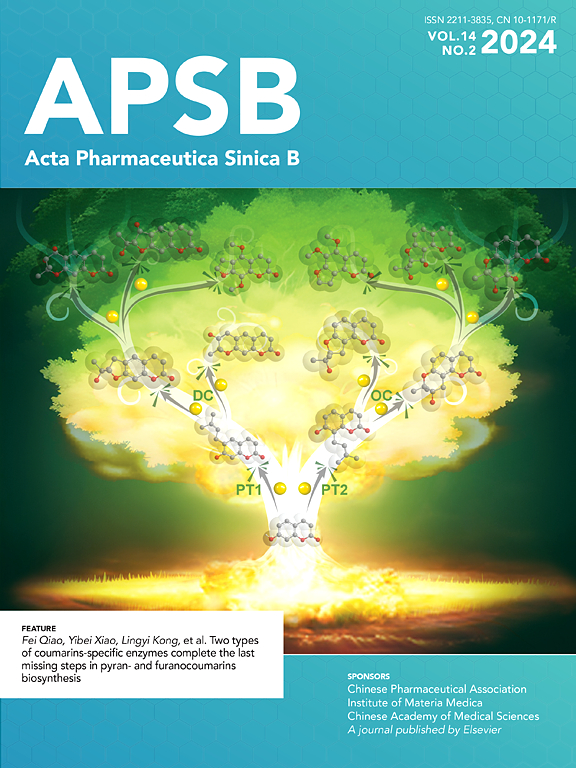纳米体驱动蛋白电晕调节治疗胶质瘤的一种新的双靶向策略
IF 14.6
1区 医学
Q1 PHARMACOLOGY & PHARMACY
引用次数: 0
摘要
胶质瘤是最常见的中枢神经系统恶性肿瘤,化疗是必不可少的辅助治疗。然而,大多数化疗药物穿透血脑屏障(BBB)的能力有限。本研究通过调节纳米体驱动蛋白冠状体的形成来提高疏水顺铂前载脂质纳米颗粒(C8Pt-Ls)的脑和肿瘤靶向效率,为胶质瘤治疗引入了一种新的双靶向策略。具体来说,具有纤维蛋白原结合能力的纳米体(Nbs)被结合到C8Pt-Ls的表面,从而产生Nb-C8Pt-Ls。在血液中,Nb-C8Pt-Ls可以结合更多的纤维蛋白原,形成与血脑屏障上高度表达的受体LRP-1特异性相互作用的蛋白冠。这种相互作用实现了“搭便车效应”机制,促进了高效的跨血脑屏障运输和促进有效的脑靶向。此外,蛋白corona与LRP-1相互作用,LRP-1在胶质瘤细胞中也过表达,从而实现精确的肿瘤靶向。计算模拟和SPR检测阐明了nb -纤维蛋白原-(LRP-1)复合物的分子相互作用机制,证实了其结合特异性和稳定性。我们的研究结果表明,该策略显著增强了脑组织和肿瘤中C8Pt的积累,诱导胶质瘤细胞凋亡,提高了治疗效果。这项研究为神经胶质瘤治疗提供了一个新的框架,并强调了基于蛋白电晕调节的双靶向策略在推进脑肿瘤治疗方面的潜力。本文章由计算机程序翻译,如有差异,请以英文原文为准。

A novel dual-targeting strategy of nanobody-driven protein corona modulation for glioma therapy
Glioma represents the most prevalent malignant tumor of the central nervous system, with chemotherapy serving as an essential adjunctive treatment. However, most chemotherapeutic agents exhibit limited ability to penetrate the blood–brain barrier (BBB). This study introduced a novel dual-targeting strategy for glioma therapy by modulating the formation of nanobody-driven protein coronas to enhance the brain and tumor-targeting efficiency of hydrophobic cisplatin prodrug-loaded lipid nanoparticles (C8Pt-Ls). Specifically, nanobodies (Nbs) with fibrinogen-binding capabilities were conjugated to the surface of C8Pt-Ls, resulting in the generation of Nb-C8Pt-Ls. Within the bloodstream, Nb-C8Pt-Ls could bound more fibrinogen, forming the protein corona that specifically interacted with LRP-1, a receptor highly expressed on the BBB. This interaction enabled a “Hitchhiking Effect” mechanism, facilitating efficient trans-BBB transport and promoting effective brain targeting. Additionally, the protein corona interacted with LRP-1, which is also overexpressed in glioma cells, achieving precise tumor targeting. Computational simulations and SPR detection clarified the molecular interaction mechanism of the Nb-fibrinogen-(LRP-1) complex, confirming its binding specificity and stability. Our results demonstrated that this strategy significantly enhanced C8Pt accumulation in brain tissues and tumors, induced apoptosis in glioma cells, and improved therapeutic efficacy. This study provides a novel framework for glioma therapy and underscores the potential of protein corona modulation-based dual-targeting strategies in advancing treatments for brain tumors.
求助全文
通过发布文献求助,成功后即可免费获取论文全文。
去求助
来源期刊

Acta Pharmaceutica Sinica. B
Pharmacology, Toxicology and Pharmaceutics-General Pharmacology, Toxicology and Pharmaceutics
CiteScore
22.40
自引率
5.50%
发文量
1051
审稿时长
19 weeks
期刊介绍:
The Journal of the Institute of Materia Medica, Chinese Academy of Medical Sciences, and the Chinese Pharmaceutical Association oversees the peer review process for Acta Pharmaceutica Sinica. B (APSB).
Published monthly in English, APSB is dedicated to disseminating significant original research articles, rapid communications, and high-quality reviews that highlight recent advances across various pharmaceutical sciences domains. These encompass pharmacology, pharmaceutics, medicinal chemistry, natural products, pharmacognosy, pharmaceutical analysis, and pharmacokinetics.
A part of the Acta Pharmaceutica Sinica series, established in 1953 and indexed in prominent databases like Chemical Abstracts, Index Medicus, SciFinder Scholar, Biological Abstracts, International Pharmaceutical Abstracts, Cambridge Scientific Abstracts, and Current Bibliography on Science and Technology, APSB is sponsored by the Institute of Materia Medica, Chinese Academy of Medical Sciences, and the Chinese Pharmaceutical Association. Its production and hosting are facilitated by Elsevier B.V. This collaborative effort ensures APSB's commitment to delivering valuable contributions to the pharmaceutical sciences community.
 求助内容:
求助内容: 应助结果提醒方式:
应助结果提醒方式:


